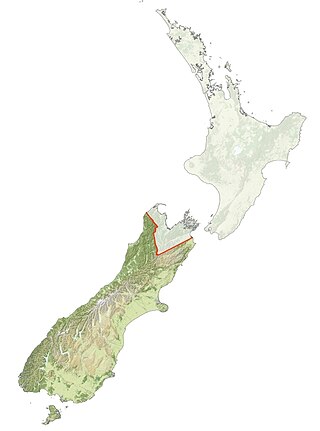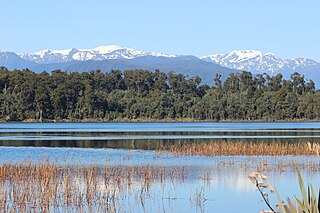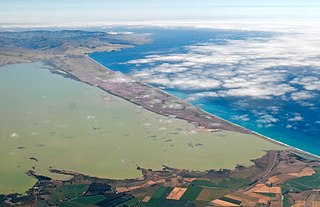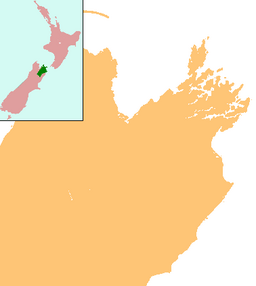
Te Rauparaha was a Māori rangatira, warlord, and chief of the Ngāti Toa iwi. One of the most powerful military leaders of the Musket Wars, Te Rauparaha fought a war of conquest that greatly expanded Ngāti Toa southwards, receiving the epithet "the Napoleon of the South". He remains one of the most prominent and celebrated New Zealand historical figures.

Ngāi Tahu, or Kāi Tahu, is the principal Māori iwi (tribe) of the South Island. Its takiwā is the largest in New Zealand, and extends from the White Bluffs / Te Parinui o Whiti, Mount Mahanga and Kahurangi Point in the north to Stewart Island / Rakiura in the south. The takiwā comprises 18 rūnanga corresponding to traditional settlements. According to the 2018 census an estimated 74,082 people affiliated with the Kāi Tahu iwi.

Kaiapoi is a town in the Waimakariri District of the Canterbury region, in the South Island of New Zealand. The town is located approximately 17 kilometres north of central Christchurch, close to the mouth of the Waimakariri River. It is considered a satellite town of Christchurch and is part of the Christchurch functional urban area.

A salt evaporation pond is a shallow artificial salt pan designed to extract salts from sea water or other brines. The salt pans are shallow and expansive, allowing sunlight to penetrate and reach the seawater. Natural salt pans are formed through geologic processes, where evaporating water leaves behind salt deposits. Some salt evaporation ponds are only slightly modified from their natural version, such as the ponds on Great Inagua in the Bahamas, or the ponds in Jasiira, a few kilometres south of Mogadishu, where seawater is trapped and left to evaporate in the sun.
Tūhawaiki — often known as Hone Tūhawaiki, John Tūhawaiki or Jack Tūhawaiki, or by his nickname of "Bloody Jack" — became a paramount chief of the Ngāi Tahu Māori iwi in the southern part of the South Island of New Zealand, and was based predominantly on Ruapuke Island. He gained his nickname from early interactions with Foveaux Strait whalers on account of his red coats bought off soldiers in Australia that he and his whailing crew wore.
Kāti Māmoe is a historic Māori iwi. Originally from the Hastings area, they moved in the 16th century to the South Island which at the time was already occupied by the Waitaha.

Lake Mahinapua is a shallow lake on the West Coast of New Zealand's South Island. Once a lagoon at the mouth of the Hokitika River, it became a lake when the river shifted its course. Lake Māhinapua was the site of a significant battle between Ngāi Tahu and Ngāti Wairangi Māori, and is regarded by them as a sacred site where swimming and fishing are prohibited. In European times it was part of an inland waterway that carried timber and settlers between Hokitika and Ross until the building of the railway. Today it is protected as a scenic reserve for boating, camping, and hiking.

The Ōnawe Peninsula is a volcanic plug inside Akaroa Harbour, on Banks Peninsula in Canterbury, New Zealand. It is the site of a former pā. It is part of the Banks Peninsula Volcano.
The history of the Canterbury Region of New Zealand dates back to settlement by the Māori people in about the 10th century.
The following lists events that happened during 1832 in New Zealand.

Te Pēhi Kupe was a Māori rangatira and war leader of Ngāti Toa and the uncle of Te Rauparaha. He took a leading part in what became known as the Musket Wars.
Te Pūoho-o-te-rangi (died 1836 or 1837), also known as Te Pūoho-ki-te-rangi, was a notable New Zealand tribal leader. A Māori, he identified with the Ngāti Tama and Ngāti Toa iwi. Te Pūoho was born in Poutama, Taranaki, New Zealand, possibly in the late eighteenth century. Late in his life, he moved to the South Island and settled at Parapara.
Tama-i-hara-nui , also known as Te Maiharanui and Tamaiharanui, was a New Zealand Māori chief of Ngāi Tahu. He was described as "strong and ruthless" and was a central figure in the 1820s "kai huanga" feud, meaning "eat relatives". Tama-i-hara-nui angered Ngāti Toa by letting a group of their chiefs into Kaiapoi pā and then killing them. Te Rauparaha, one of the Ngāti Toa chiefs who stayed outside of the pā, returned to Banks Peninsula in November 1830 and captured Tama-i-hara-nui. He was taken to Ōtaki, where he was tortured by the wives of the chiefs who had been killed at Kaiapoi pā, and then killed himself.
Te Mātenga Taiaroa was a leader of Ngāi Tahu, a Māori iwi (tribe) of the South Island of New Zealand. Taiaroa belonged to Ngāi Te Ruahikihiki and Ngāti Moki hapū of Ngāi Tahu, which were centred on Taumutu, at the southern end of Lake Ellesmere / Te Waihora. From the 1830s to the 1860s, he was a leader at Ōtākou on the Otago Peninsula in association with his cousin Karetai. in the 1830s he fought against Te Rauparaha and Ngāti Toa, sometimes in conjunction with Tūhawaiki. He was later involved in peacemaking with Ngāti Toa. In 1856 he attended the meeting of Māori chiefs at Pūkawa, Lake Taupō, which elected Pōtatau Te Wherowhero as the first Māori King. In 1860 he attended the Kohimarama conference of Māori chiefs in Auckland, organised by the government. In 1859 Taiaroa was baptised by a Methodist minister and took the Christian name of Te Mātenga (Marsden). Hōri Kerei Taiaroa was one of his children.
The history of the Nelson Region of New Zealand dates back to settlement by the Māori people in about the 12th century. The Nelson and Marlborough Region were known to the Māori as Te Tau Ihu o Te Waka a Maui which means "The Prow of the Canoe of Maui".

Takapūneke, with the location also known as Red House Bay, is a former kāinga—an unfortified Māori village—adjacent to present-day Akaroa, New Zealand. Takapūneke was a major trading post for the local iwi (tribe), Ngāi Tahu, as there was safe anchorage for European vessels. The site is of significance to Ngāi Tahu as their tribal chief, Tama-i-hara-nui, was captured here by North Island Ngāti Toa chief Te Rauparaha, and then tortured and killed. The village itself was raided and subject of a massacre, with the events subsequently called the Elizabeth affair. There is a direct link from the massacre in 1830 to the signing of the Treaty of Waitangi in 1840, giving the site a status of national significance.
Ngāti Tūmatakōkiri is a Māori iwi (tribe) of New Zealand, who arrived on the Kurahaupō waka. In the 1600s the iwi settled northwestern South Island, becoming a major power in the region until the 1800s. In 1642, members of Ngāti Tūmatakōkiri made the first known contact between Europeans and Māori, when Dutch explorer Abel Tasman visited Golden Bay / Mohua.
Coopers Lagoon / Muriwai is a small coastal waituna-type lagoon in the Canterbury region of New Zealand, located approximately half way between the mouth of the Rakaia River and the outlet of the much larger Lake Ellesmere / Te Waihora. While the present-day lagoon is separated from the nearby Canterbury Bight by approximately 100 metres (330 ft), the water of the lagoon is considered brackish and early survey maps show that, until recently, the lagoon was connected to the ocean by a small channel. The lagoon, along with the surrounding wetlands, has historically been an important mahinga kai for local Māori.

A waituna is a freshwater coastal lagoon on a mixed sand and gravel (MSG) beach, formed where a braided river meets a coastline affected by longshore drift. This type of waterbody is neither a true lake, lagoon nor estuary.
Ross Calman is a New Zealand Māori writer, editor, historian, and translator of the Māori language.











